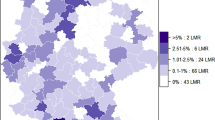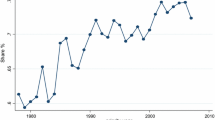Abstract
Have Chinese universities, after enormous investment over the past decade, embraced the university’s third mission—contributing to industrial and technological progress? The literature has not sufficiently addressed this question. This study intends to advance understanding of this issue by empirically addressing this question from a business perspective in a bold and unconventional way. Unlike prior studies that simply used contingent and institutional factors to describe the link between Chinese universities and industrial firms by measuring such aspects as patent licensing, co-patenting, and co-authoring, our work goes further and applies longitudinal analysis to examine the ways firms access university-level knowledge and the impact of such knowledge on firm innovation outputs. We propose that if Chinese universities embraced their third mission, then we would observe a positive effect of university–industry collaborations on firms’ subsequent innovation outputs. Empirical results based on a sample of the top 100 Chinese electronic firms in terms of output value support our hypothesis. Specifically, university patent licensing and co-patenting between universities and firms was found to positively affect firm innovation outputs. Moreover, we found that geographical distance and collaboration dominance moderate the co-patenting–innovation output relationship.

Similar content being viewed by others
References
Abramo, G., D’Angelo, C. A., & Pugini, F. (2008). The measurement of Italian universities’ research productivity by a non parametric–bibliometric methodology. Scientometrics, 76(2), 225–244.
Abramo, G., D’Angelo, C. A., & Solazzi, M. (2012). A bibliometric tool to assess the regional dimension of university–industry research collaborations. Scientometrics, 91(3), 955–975.
Aggarwal, A. (2000). Deregulation, technology imports and in-house R&D efforts: an analysis of the Indian experience. Research Policy, 29(9), 1081–1093.
Ahuja, G., & Katila, R. (2001). Technological acquisitions and the innovation performance of acquiring firms: A longitudinal study. Strategic Management Journal, 22(3), 197–220.
Almeida, P., & Kogut, B. (1997). The exploration of technological diversity and the geographic localization of innovation. Small Business Economics, 9(1), 21–31.
Altenburg, T., Schmitz, H., & Stamm, A. (2008). Breakthrough? China’s and India’s transition from production to innovation. World Development, 36(2), 325–344.
Arora, A. (1996). Contracting for tacit knowledge: The provision of technical services in technology licensing contracts. Journal of Development Economics, 50, 233–256.
Baldini, N. (2006). The act on inventions at public research institutions: Danish universities’ patenting activity. Scientometrics, 69(2), 387–407.
Becker, W., & Dietz, J. (2004). R&D cooperation and innovation activities of firms: Evidence for the German manufacturing industry. Research Policy, 33(2), 209–223.
Bekkers, R., & Bodas Freitas, I. M. (2008). Analysing knowledge transfer channels between universities and industry: To what degree do sectors also matter? Research Policy, 37(10), 1837–1853.
Bell, M., & Pavitt, K. (1993). Technological accumulation and industrial growth: Contrasts between developed and developing countries. Industrial & Corporate Change, 2(2), 157–210.
Chatterjee, S., & Price, B. (1991). Regression analysis by example. New York: Wiley.
Chen, J., Jang, S.-L., & Chang, C.-H. (2013). The patterns and propensity for international co-invention: The case of China. Scientometrics, 94(2), 481–495.
Chesbrough, H. W. (2003). Open innovation: The new imperative for creating and profiting from technology. Boston, MA: Harvard Business School Press.
Cohen, W. M., & Levinthal, D. A. (1990). Absorptive capacity: A new perspective on learning and innovation. Administrative Science Quarterly, 35, 128–152.
Desai, A. V. (1980). The origin and direction of industrial R&D in India. Research Policy, 9(1), 74–96.
Ding, J., & Qiu, J. (2011). An approach to improve the indicator weights of scientific and technological competitiveness evaluation of Chinese universities. Scientometrics, 86(2), 285–297.
Duysters, G., Jacob, J., Lemmens, C., & Yu, J. (2009). Internationalization and technological catching up of emerging multinationals: A comparative case study of China’s Haier group. Industrial and Corporate Change, 18(2), 325–349.
Etzkowitz, H., & Leydesdorff, L. (2000). The dynamics of innovation: From national systems and “Mode 2” to a triple helix of university–industry–government relations. Research Policy, 29(2), 109–123.
Eun, J.-H., Lee, K., & Wu, G. (2006). Explaining the “uniniversity-run enterprises” in China: A theoretical framework for university–industry relationship in developing countries and its application to China. Research Policy, 35(9), 1329–1346.
Fasella, P. M. (1999). Universities: Engines of innovation in the information society. Scientometrics, 45(3), 543–545.
Freeman, C. (1988). Japan: A new national innovation system. In G. Dosi, C. Freeman, R. R. Nelson, G. Silverberg, & L. Soete (Eds.), Technology and economic theory. London: Pinter Publishers.
Fu, X., Pietrobelli, C., & Soete, L. (2011). The role of foreign technology and indigenous innovation in the emerging economies: Technological change and catching-up. World Development, 39(7), 1204–1212.
Grant, R. M. (1996). Toward a knowledge-based theory of the firm. Strategic Management Journal, 17, 109–122.
Greene, W. (2008). Functional forms for the negative binomial model for count data. Economics Letters, 99(3), 585–590.
Guan, J., Yam, R. C. M., & Mok, C. (2005). Collaboration between industry and research institutes/universities on industrial innovation in Beijing. China. Technology Analysis & Strategic Management, 17(3), 339–353.
Hagedoorn, J. (1993). Understanding the rationale of strategic technology partnering: Inter-organizational modes of cooperation and sectoral differences. Strategic Management Journal, 14, 371–385.
Hall, B. H., Jaffe, A. B., & Trajtenberg, M. (1999). Market value and patent citations. NBER working paper, Paris.
Hausman, J. A., & Griliches, Z. (1984). Econometric models for count data with an application to the patents–R&D relationship. Economic and Political Weekly, 27, 909–938.
Henderson, R., Jaffe, A., & Trajtenberg, M. (1998). Universities as a source of commercial technology: A detailed analysis of university patenting 1965–1988. Review of Economic and Statistics, 80, 119–127.
Hershberg, E., Nabeshima, K., & Yusuf, S. (2007). Opening the ivory tower to business: University–industry linkages and the development of knowledge-intensive clusters in Asian cities. World Development, 35(6), 931–940.
Hong, W. (2008). Decline of the center: The decentralizing process of knowledge transfer of Chinese universities from 1985 to 2004. Research Policy, 37(4), 580–595.
Hottenrott, H., & Thorwarth, S. (2011). Industry funding of university research and scientific productivity. Kyklos, 64(4), 534–555.
Jaffe, A. B., & Trajtenberg, M. (1993). Geographic localization of knowledge spillovers as evidenced by patent citations. Quarterly Journal of Economics, 108(3), 577–598.
Johnson, D. K. N. (2002). ‘Learning-by-licensing’: R&D and technology licensing in Brazilian invention. Economics of Innovation & New Technology, 11(3), 163–177.
Katrak, H. (1990). Imports of technology and the technological effort of Indian enterprises. World Development, 18(3), 371–381.
Kroll, H., & Liefner, I. (2008). Spin-off enterprises as a means of technology commercialisation in a transforming economy: Evidence from three universities in China. Technovation, 28(5), 298–313.
Lei, X.-P., Zhao, Z.-Y., Zhang, X., Chen, D.-Z., Huang, M.-H., & Zhao, Y.-H. (2012). The inventive activities and collaboration pattern of university–industry–government in China based on patent analysis. Scientometrics, 90(1), 231–251.
Leydesdorff, L., & Meyer, M. (2003). The triple helix of university–industry–government relations. Scientometrics, 58(2), 191–203.
Li, F., Yi, Y., Guo, X., & Qi, W. (2012). Performance evaluation of research universities in Mainland China, Hong Kong and Taiwan: Based on a two-dimensional approach. Scientometrics, 90(2), 531–542.
Liang, L., Chen, L., Wu, Y., & Yuan, J. (2012). The role of Chinese universities in enterprise: University research collaboration. Scientometrics, 90(1), 253–269.
Liefner, I., & Schiller, D. (2008). Academic capabilities in developing countries: A conceptual framework with empirical illustrations from Thailand. Research Policy, 37(2), 276–293.
Liefner, I., Hennemann, S., & Lu, X. (2006). Cooperation in the innovation process in developing countries: Empirical evidence from Beijing Zhongguancun. Environment and Planning, 38(1), 111–130.
Liu, X. (2005). China’s development model: An alternative strategy for technological catch-up. Working paper, Hitotsubashi.
Liu, X., & White, S. (2001). Comparing innovation systems: A framework and application to China’s transitional context. Research Policy, 30(7), 1091–1114.
Liu, X. L., & Zhi, T. T. (2010). China is catching up in science and innovation: The experience of the Chinese academy of sciences. Science and Public Policy, 37(5), 331–342.
Luan, C., Zhou, C., & Liu, A. (2010). Patent strategy in Chinese universities: A comparative perspective. Scientometrics, 84(1), 53–63.
Lundvall, B.-Å. (1992). National systems of innovation: Towards a theory of innovation and interactive learning. London, New York: Pinter Publishers.
Manjarrés-Henríquez, L., Gutiérrez-Gracia, A., & Vega-Jurado, J. (2008). Coexistence of university–industry relations and academic research: Barrier to or incentive for scientific productivity. Scientometrics, 76(3), 561–576.
Mansfield, E., Romeo, A., Schwartz, M., Teece, D., Wagner, S., & Brach, P. (1982). Technology transfer, productivity, and economic policy. New York: Norton.
Molas-Gallart, J., & Sinclair, T. (1999). From technology generation to technology transfer: The concept and reality of the “Dual-Use Technology Centres”. Technovation, 19(11), 661–671.
Motohashi, K. (2008). Assessment of technological capability in science industry linkage in China by patent database. World Patent Information, 30(3), 225–232.
Motohashi, K., & Yun, X. (2007). China’s innovation system reform and growing industry and science linkages. Research Policy, 36(8), 1251–1260.
Mowery, D. C., & Ziedonis, A. A. (2002). Academic patent quality and quantity before and after the Bayh-Dole act in the United States. Research Policy, 31(3), 399.
Nabeshima, K., & Yusuf, S. (2007). Opening the ivory tower to business: University–industry linkages and the development of knowledge-intensive clusters in Asian cities. World Development, 35(6), 931–940.
Nelson, R. R., & Winter, S. G. (1982). An evolutionary theory of economic change. Boston: Belknap Press of Harvard University Press.
Nerkar, A. (2003). Old is gold? The value of temporal exploration in the creation of new knowledge. Management Science, 49(2), 211–229.
Nieto, M. J., & Santamaría, L. (2007). The importance of diverse collaborative networks for the novelty of product innovation. Technovation, 27(6/7), 367–377.
Nonaka, I. (1994). A dynamic theory of organizational knowledge creation. Organization Science, 5(1), 14–37.
Powell, W. W., Koput, K. W., & Smith-Doerr, L. (1996). Interorganizational collaboration and the locus of innovation: Networks of learning in biotechnology. Administrative Science Quarterly, 41(1), 116–145.
Saxeninan, A. (1994). Regional advantage. Cambridge, MA: Harvard University Press.
Scott-Kemmis, D., & Bell, M. (1985). Technological dynamism and technological content of collaboration: Are Indian firms missing opportunities? Economic and Political Weekly, 20(45/47), 1991–2004.
Singh, J. (2008). Distributed R&D, cross-regional knowledge integration and quality of innovative output. Research Policy, 37(1), 77–96.
Teece, D. J. (1986). Profiting from technological innovation: Implications for integration, collaboration, licensing and public policy. Research Policy, 15, 285–305.
Trajtenberg, M. (1990). A penny for your quotes: Patent citations and the value of innovations. RAND Journal of Economics, 21(1), 172–187.
Wang, Y., & Zhou, Z. (2012). The dual role of local sites in assisting firms with developing technological capabilities: Evidence from China. International Business Review. http://dx.doi.org/10.1016/j.ibusrev.2012.02.003.
Wang, Y., Roijakkers, N., Vanhaverbeke, W., & Chen, J. (2012). How Chinese firms employ open innovation to strengthen their innovative performance. International Journal of Technology Management, 59(3/4), 235–254.
Whitley, R. (2002). Developing innovative competences: The role of institutional frameworks. Industrial & Corporate Change, 11(3), 497–528.
Wu, W., & Zhou, Y. (2011). The third mission stalled? Universities in China’s technological progress. The Journal of Technology Transfer, 36(2), 173–202.
Wu, W., & Zhou, Y. (2012). The third mission stalled? Universities in China’s technological progress. The Journal of Technology Transfer, 37(6), 812–827.
Zhang, H., Patton, D., & Kenney, M. (2013). Building global-class universities: Assessing the impact of the 985 project. Research Policy, 42(3), 765–775.
Zhao, Q., & Guan, J. (2012). Modeling the dynamic relation between science and technology in nanotechnology. Scientometrics, 90(2), 561–579.
Zhou, W. (2012). Determinants and effects of research partnerships in China’s emerging market. Contemporary Economic Policy, 30(1), 129–147.
Acknowledgments
This research is supported by Funding of Sichuan University (No. skyb201302) and the Humanity and Social Science Youth foundation of Ministry of Education of China (No. 13YJC790154, and National Science Foundation of China (NSFC, grant no. 71003061; 71033001; 71273230) and National Social Science Foundation of China (NSSFC, grant no. 12&ZD098; 12&ZD199). The authors express greetings to the peer reviewers too.
Author information
Authors and Affiliations
Corresponding author
Rights and permissions
About this article
Cite this article
Wang, Y., Huang, J., Chen, Y. et al. Have Chinese universities embraced their third mission? New insight from a business perspective. Scientometrics 97, 207–222 (2013). https://doi.org/10.1007/s11192-013-1055-z
Received:
Published:
Issue Date:
DOI: https://doi.org/10.1007/s11192-013-1055-z




